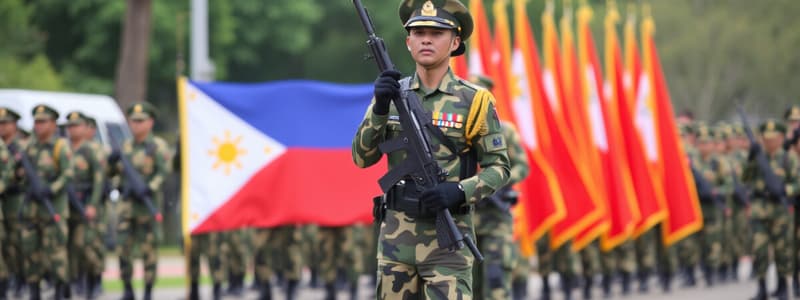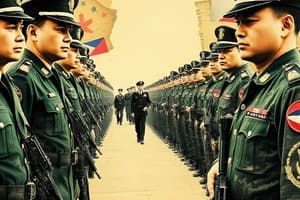Podcast
Questions and Answers
Lapu-Lapu is considered the acknowledged father of the ______.
Lapu-Lapu is considered the acknowledged father of the ______.
AFP
The revolt led by Dagohoy took place in ______.
The revolt led by Dagohoy took place in ______.
1744
Andres Bonifacio founded the Katipunan on 07 July ______.
Andres Bonifacio founded the Katipunan on 07 July ______.
1892
The Tejeros Convention, which proclaimed the desire for independence, occurred on 22 March ______.
The Tejeros Convention, which proclaimed the desire for independence, occurred on 22 March ______.
The Philippine Independence was declared on 12 June ______.
The Philippine Independence was declared on 12 June ______.
The National Defense Act that officially created the AFP was enacted on 21 December ______.
The National Defense Act that officially created the AFP was enacted on 21 December ______.
The Philippine Air Force was established on 01 July ______.
The Philippine Air Force was established on 01 July ______.
The Philippine Military Academy was organized on 25 October ______.
The Philippine Military Academy was organized on 25 October ______.
The AFP is a well-organized and disciplined body composed of a citizen armed ______ necessary for the defense and security of the state.
The AFP is a well-organized and disciplined body composed of a citizen armed ______ necessary for the defense and security of the state.
The organizational structure of the AFP provides for centralized direction and control from ______ to ensure unity of efforts.
The organizational structure of the AFP provides for centralized direction and control from ______ to ensure unity of efforts.
The Regular Force is the permanent military organization that is maintained in time of ______ and war.
The Regular Force is the permanent military organization that is maintained in time of ______ and war.
The Reserve Force will come into ______ only upon mobilization called by the Commander-In-Chief.
The Reserve Force will come into ______ only upon mobilization called by the Commander-In-Chief.
The President is the ______ of the AFP and exercises strategic direction over military personnel.
The President is the ______ of the AFP and exercises strategic direction over military personnel.
The Secretary of National Defense exercises supervision and ______ over the AFP.
The Secretary of National Defense exercises supervision and ______ over the AFP.
The CSAFP executes the command functions of the President in relation to ______, tactics, and operations.
The CSAFP executes the command functions of the President in relation to ______, tactics, and operations.
For operational efficiency, the AFP is presently composed of three Major Service ______ namely: Philippine Army, Navy, and Air Force.
For operational efficiency, the AFP is presently composed of three Major Service ______ namely: Philippine Army, Navy, and Air Force.
The Philippine Revolutionary Navy was organized by General Emilio ______.
The Philippine Revolutionary Navy was organized by General Emilio ______.
The Navy was placed under the Department of ______ headed by General Mariano Trias.
The Navy was placed under the Department of ______ headed by General Mariano Trias.
The initial fleet consisted of eight Spanish steam ______ captured from the Spaniards.
The initial fleet consisted of eight Spanish steam ______ captured from the Spaniards.
Notable vessels donated included the TAALENO, BALAYAN, BULUSAN, TAAL and the ______ CONCEPCION.
Notable vessels donated included the TAALENO, BALAYAN, BULUSAN, TAAL and the ______ CONCEPCION.
The naval ship ______ almost encountered the German cruiser, Irene.
The naval ship ______ almost encountered the German cruiser, Irene.
TAALENO and DON FRANCISCO were the first naval boats used in the ______.
TAALENO and DON FRANCISCO were the first naval boats used in the ______.
The naval forces supported ground operations and transported Filipino troops and war ______ to different islands.
The naval forces supported ground operations and transported Filipino troops and war ______ to different islands.
Marines and reconnaissance divers trained by General Ananias ______ were sent to liberate Bicol and the Visayas.
Marines and reconnaissance divers trained by General Ananias ______ were sent to liberate Bicol and the Visayas.
The Off Shore Patrol (OSP) was organized on 09 February _____.
The Off Shore Patrol (OSP) was organized on 09 February _____.
The first Commandant of the OSP Training School was CAPT MARCELO S _____.
The first Commandant of the OSP Training School was CAPT MARCELO S _____.
The OSP was renamed Philippine Naval Patrol (PNP) on 04 October _____.
The OSP was renamed Philippine Naval Patrol (PNP) on 04 October _____.
During World War II, Japanese planes bombed the OSP Headquarters on 23 December _____.
During World War II, Japanese planes bombed the OSP Headquarters on 23 December _____.
The OSP Training School offered courses in seamanship, torpedoes, and operations of gasoline _____.
The OSP Training School offered courses in seamanship, torpedoes, and operations of gasoline _____.
The ______ Air Force is responsible for the air defense of the country.
The ______ Air Force is responsible for the air defense of the country.
The ______ Navy is responsible for the naval defense of the archipelago.
The ______ Navy is responsible for the naval defense of the archipelago.
Each service command considers the other services as ______-in-arms.
Each service command considers the other services as ______-in-arms.
The mission of the Armed Forces of the ______ is to protect the people and secure the sovereignty.
The mission of the Armed Forces of the ______ is to protect the people and secure the sovereignty.
The Naval Reserve Command aims to provide the Philippine Navy base for ______ in the event of war.
The Naval Reserve Command aims to provide the Philippine Navy base for ______ in the event of war.
Early Filipino inhabitants came from across the seas - from Ancient ______, Borneo and Malay Peninsula.
Early Filipino inhabitants came from across the seas - from Ancient ______, Borneo and Malay Peninsula.
The destruction of the Spanish ______ became a major component of the revolutionary undertaking.
The destruction of the Spanish ______ became a major component of the revolutionary undertaking.
The Filipino nationalists recognized that the Philippines is a ______ country.
The Filipino nationalists recognized that the Philippines is a ______ country.
Flashcards are hidden until you start studying
Study Notes
History of the AFP
- Battle of Mactan on 27 April 1521 showcases Lapu-Lapu’s role in the fight for freedom, earning him the title of the father of the AFP.
- The Dagohoy Revolt in 1744 and various Muslim uprisings reflect Filipino resistance against Spanish colonial rule.
- Katipunan founded on 07 July 1892 by Andres Bonifacio promotes unity among Filipinos in their quest for independence.
- Tejeros Convention, held on 22 March 1897, formally expresses the desire for independence and leads to the establishment of the Philippine Army.
- Philippine Navy established on 20 May 1898 as part of the movement for national defense.
- Declaration of Philippine Independence on 12 June 1898 by General Emilio Aguinaldo, featuring the first hoisting of the Philippine Flag and the national anthem.
- Filipino-American War (1898-1899) highlights the bravery and loyalty of Filipino soldiers despite enemy superiority.
- Philippine Military Academy founded on 25 October 1898 to strengthen military training and organization.
- National Defense Act enacted on 21 December 1935 officially creates the Armed Forces of the Philippines (AFP).
- Defense of Bataan and Corregidor during World War II (April-May 1942) exemplifies Filipino military resilience against Japanese forces.
- Philippine Air Force established on 01 July 1947 to enhance aerial defense.
- AFP's commitment to international peacekeeping demonstrated through participation in PEFTOK, missions in Congo, and civic action in Vietnam post-EDSA Revolution.
Organization of the AFP
- Created by law as part of the Executive Branch, the AFP serves as a disciplined citizen armed force for national security.
- Centralized direction from the General Headquarters (GHQ) ensures unity, while decentralization enhances operational efficiency.
- Composed of Regular Force (permanent military) and Reserve Force (mobilized during national emergencies).
- President Ferdinand R. Marcos Jr. serves as Commander-in-Chief, overseeing strategic military direction.
- Secretary of National Defense supervises the AFP, executing policies established by the President.
- Chief of Staff of the AFP (General Andres C. Centino) implements command functions and advises on defense programs.
AFP Major Service Commands
- Philippine Army (PA): Multifunctional force engaged in combat operations and development missions.
- Philippine Air Force (PAF): Responsible for the country's air defense and aerial operations.
- Philippine Navy (PN): Ensures naval defense and maritime operations.
AFP Mission
- Primary mission is to protect the people and safeguard national sovereignty.
- Philippine Navy focuses on organizing, training, and maintaining naval forces for maritime operations.
- Naval Reserve Command aims to prepare reservists for expanded operations during emergencies or disasters.
History of the Philippine Navy
- Filipino seafarers engaged in trade and navigation, establishing the Philippines as a maritime nation.
- Spanish era saw local sailors support imperial expeditions, recognizing the significance of naval strength in independence efforts.
- Revolutionary Navy established in June 1898 under General Emilio Aguinaldo, initially comprising captured Spanish vessels.
- Commodore Pascual Ledesma appointed as the first Navy Director, supporting land operations against Spanish forces.
- The Navy played a crucial role in transporting troops and materials, enhancing revolutionary efforts across the archipelago.
Offshore Patrol and Expansion
- Offshore Patrol (OSP) formed on 09 February 1939 as a component of the Philippine Army; initially equipped with US Navy motor torpedo boats.
- OSP Training School established on 09 January 1941, offering naval training programs.
- Reactivated post-WWII, the OSP evolved into the Philippine Naval Patrol on 04 October 1947, and was finally designated as the Philippine Navy on 05 January 1951.
Studying That Suits You
Use AI to generate personalized quizzes and flashcards to suit your learning preferences.




